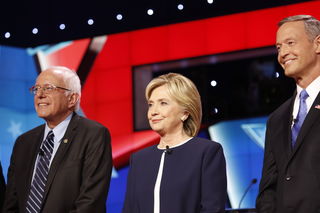Optimism
To Be Elected President, It Helps to Be an Optimist
A classic study revealed what really separates victory from defeat.
Posted November 24, 2015
- “The world is on fire." "Americans will die.”
- “America is adrift. Something is clearly wrong.”
- “America is a hellhole, and we’re going down fast.”
These are not the chants of America’s enemies abroad, but the pronouncements of current presidential candidates Ted Cruz, Rand Paul, and Donald Trump.

But not everyone running for the country’s top job is equally pessimistic. Consider John Kasich’s rhetorical question: “Why don’t we count our blessings for having been born in the United States of America?”; Hillary Clinton’s pronouncement that “America can lead the world in the 21st century”; and Jeb Bush’s pledge, “We’re on the verge of the greatest time to be alive.”
So in 2016, will it be the optimists or the pessimists who will carry the day?
The field of well-being science has an answer: Studies have shown that happier and more positive people are better liked, more sought out as friends, and regarded as more energetic, more resilient, and more creative. Optimistic leaders are perceived to be more effective, and happier people are even judged to be more likely to go to Heaven. This research included a variety of participants, from undergraduates to CEOs, and is certainly suggestive. But wouldn’t it be nice if psychological scientists could analyze the positivity of presidential candidates and relate it to the outcomes of actual elections? As luck would have it, two University of Pennsylvania researchers already have.
In their classic study, Harold Zullow and Martin Seligman analyzed the party nomination acceptance speeches of presidential candidates from 22 elections—from the turn of the century (McKinley vs. Bryan) to 1984 (Reagan vs. Mondale). Widely covered by the media, and televised since 1948, the Democratic and Republican convention speeches are highly informative vis-à-vis a candidate’s perspective on the state of the nation and his goals for the future. Remarkably, presidential candidates whose acceptance speeches were sunnier and less likely to dwell on negatives went on to win 18 out of the 22 elections studied. Further, the more positive the candidate was, relative to his opponent—for example, projecting optimism that America’s problems were temporary and that he was the one to set things right—the wider his victory margin. And the more positive the candidate, the more active he was on the campaign trail—for example, making more frequent stump speeches.
In the last election studied by Zullow and Seligman, Ronald Reagan—he of the campaign spot that famously began, “It’s morning again in America”—trounced the more ruminative Walter Mondale in a landslide. In more recent history, we could cite Bill Clinton calling for building a “bridge to the 21st century” at the 1996 convention, George W. Bush’s “Yes, America Can!” campaign slogan, and Barack Obama’s ubiquitous "Hope" and “Yes We Can!” posters. In the last 30 years, the more positive candidate appears to have triumphed most of the time.
But what if conditions in the country truly are bad? Let’s say the economy is tanking, violence is threatening, and our children face a bleaker future. Shouldn't a realistic candidate be pessimistic? In regard to this question, it’s interesting to examine the exceptions to Zullow and Seligman’s findings—the elections in which the more pessimistic candidate won. As it happens, three of the four anomalies were the three re-election campaigns of Franklin Delano Roosevelt (1936, 1940, and 144), all of which took place during the epic crises of the Great Depression and World War II. Perhaps FDR was a special candidate, whose three re-elections made him unique. Or perhaps, when things are objectively miserable, delivering an optimistic message renders a candidate unrealistic and out of touch at best, and in denial or ignorant at worst.
This year’s candidates so far are not exactly founts of positivity, with several suggesting that America has become (or been allowed to become) second-rate. Yet, we should keep in mind that practicing positive politics does not require being a Pollyanna who lives in the “best of all possible worlds” (per Candide). A positive leader exudes the confidence that we as a nation can pull together, move forward, and solve our problems. He or she is a leader who inspires hope in voters—rather than hopelessness.
In the words of the early 20th-century Italian political theorist Antonio Gramsci, the key may be to embody “pessimism of the intellect, optimism of the will”—that is, to present oneself as an idealistic realist (as Hillary Clinton has) or to balance calls for change or even revolution (per Bernie Sanders) with sober pronouncements of our nation’s problems. We’ll know soon enough if the 2016 election proves consistent with the pattern revealed by Zullow and Seligman, and if Americans once again select the candidate who projects the most hope for our country’s future.
A shorter version of this piece appeared in the Los Angeles Times on November 5, 2015.


